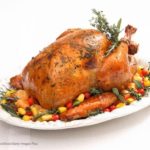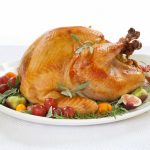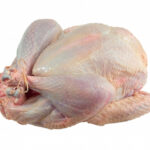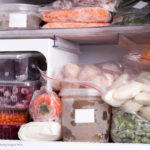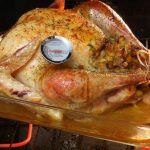Get Thanksgiving turkey safety tips from the USDA, including how to thaw and cook the bird, for a safe holiday. The biggest meal of the year comes with special food safety issues, especially regarding the turkey. The first step is thawing the turkey, if you purchased a frozen bird. Never ever thaw turkey or any meats at room temperature. Turkey can be thawed in the fridge; allow 24 hours for every four pounds of turkey. That means if you bought a 16 pound turkey, you need to allow four full days for thawing. After the turkey is thawed using this method, it can be kept, uncooked, in the fridge for two days. You can also thaw the turkey in cold water. Allow 30 minutes of thawing per pound, and submerge the turkey in its original wrapping. Change the water eery 30 minutes until the … [Read more...]
Store Thanksgiving Leftovers Safely to Stay Healthy
After the holidays, one of the best things is having lots of great leftovers to eat. But you need to store Thanksgiving leftovers safely to stay healthy. Here are some rules to follow from Food Safety.gov. Food safety starts as soon as you take the food out of the oven or the refrigerator to serve it. Make sure that all perishable foods, which include meats, cheeses, cut fruits and vegetables, and casseroles, are put into the fridge or freezer within two hours. That time period shrinks to one hour if the ambient air temperature is above 90°F. Divide the food into smaller portions so it cools quickly. A whole turkey or a large casserole will take too long to cool down, meaning it can stay in the danger zone of 40°F to 140°F too long. In that temperature range, pathogenic bacteria … [Read more...]
Alternate Turkey Preparation Methods From the USDA
The USDA is offering tips on alternate turkey preparation methods for the Thanksgiving holiday. If you choose to prepare turkey other than roasting it in the oven, read carefully to avoid food poisoning or injuries. Whatever method you use, make sure that the turkey reaches 165°F, a temperature that must be read with a reliable and accurate thermometer. First, do not cook the turkey in brown paper bags from the grocery store. That product can emit toxic fumes and may cause a fire. The ink, glue and recycled materials in brown paper bags are especially toxic. Electric Roaster Oven If you choose to use an electric roaster oven, the cooking times and temperatures should be the same as in a conventional oven. But always read the user manual for the manufacturer's instructions. The … [Read more...]
Learn How to Cook Turkey Stuffing Safely From the USDA
Learn how to cook turkey stuffing safely with tips from the USDA. Turkey stuffing is risky because it's a large mass of food cooked inside the bird, so getting the mixture to a safe final internal temperature of 165°F, especially in the center, is tricky. The USDA recommends that you do not cook your stuffing inside of the turkey, especially if your guests fall into groups that are at high risk for serious complications from food poisoning. Put the stuffing, or dressing, into a casserole dish and bake it along with the turkey. The dressing must still reach 165°F, tested with a reliable and accurate food thermometer. If you do decide to stuff the turkey, there are some rules to follow. First, never stuff the turkey ahead of time. Bacteria can multiply and grow in the stuffing … [Read more...]
Safely Thaw Your Thanksgiving Turkey With USDA Tips
Learn yow to safely thaw your Thanksgiving turkey with these timely tips from the USDA. If you bought a frozen turkey, now is the time to start thawing it so it's ready to cook on the big day. It's critical that you learn this fact: never ever thaw your turkey, or any frozen food, at room temperature unless the package specifically states that it's safe to do so. If you thaw meat products, especially, at room temperature, the product will sit at the danger zone of 40°F to 140°F for too long. And bacterial counts double in amount every hour in that temperature range. Since bacteria can produce toxins as they grow that are not destroyed by heat, cooking a contaminated turkey may not make it safe to eat. And you could get sick. The USDA says that one of the most common question … [Read more...]
Should You Buy a Fresh or Frozen Turkey For Thanksgiving?
Should you buy a fresh or frozen turkey for Thanksgiving? That holiday is next week. The USDA has some tips to make sure you have a safe and healthy dinner. Turkeys are sold both fresh and frozen. You can often order the type and size of turkey that you want ahead of time, but if you haven't done this, you need to make some decisions. Food safety is critical at all times, of course, but holiday dinners are special. You may have elderly guests at your dinner, or a pregnant woman, or small children, or someone with a chronic illness or compromised immune system. In that case, you must be very careful to make sure that the food you serve is completely safe to eat. And turkey storage and preparation play a large part in food safety. Here's what the USDA says about which type of … [Read more...]
Thanksgiving Leftovers Must Be Discarded or Frozen Today
It's now four days after Thanksgiving, and that means that all leftovers from that holiday dinner must be discarded or frozen today, according to the USDA. Of course, this is assuming that you refrigerated that food promptly - within two hours of it coming out of the fridge or oven. Between the temperature range of 40°F to 140°F, bacteria numbers can double in foods every 20 minutes. And those pathogens can make toxins that aren't destroyed by heat. So even if you thoroughly reheat leftovers to 165°F, as you should every time, you may still get sick. That's why we stress prompt refrigeration of perishable foods, including meats, egg dishes, seafood, poultry, casseroles, and cooked vegetables. To freeze foods, store them in freezer bags or other containers in relatively small … [Read more...]
Unsafe Ways to Prepare Your Thanksgiving Turkey
Did you know that there are unsafe ways to prepare your Thanksgiving turkey? While we have covered prepping and cooking the turkey safely, including proper thawing and roasting to the correct temperature, there are other physical parts to the preparation to think about. First of all, the method you use for cooking your turkey is important. You can roast the turkey, grill it, or deep fry it. Roasting is the most common method, and it is the safest, both in terms of food safety and physical safety. Grilling is the next safest, as long as you keep an eye on the bird, understand the risks of grilling such as fire and burns, and use a food thermometer. Just never use a grill in a covered area, not even a breezeway or the garbage because you risk carbon monoxide poisoning. But deep … [Read more...]
Learn How to Safely Prepare a Turkey For Thanksgiving
Thanksgiving is Thursday! Most people will be having turkey and stuffing. Read on to learn how to safely prepare a turkey for Thanksgiving dinner. While this task isn't difficult, there are some rules you should follow to avoid food poisoning. The Centers for Disease Control and Prevention (CDC) has tips. First, plan ahead. If you buy a frozen turkey it needs time to thaw - in the refrigerator. Never thaw a turkey on the counter or you are inviting trouble. Allow 24 hours of thawing for every four to five pounds of bird. If you have a big turkey, it may be too late at this point. In that case, you still have options. You can thaw the turkey in cold water, but you have to keep an eye on it. Make sure the turkey is in a leakproof bag before you put it in the sink. Add cold water … [Read more...]
Thanksgiving Food Safety Tips From the USDA
Thanksgiving food safety tips from the USDA will help you keep your family and friends safe as you celebrate the holiday this year. Follow the basic four steps to food safety - clean, separate, cook, and chill. But there are other tips you need to keep in mind. Handwashing is the first step to avoiding any foodborne illness. Wash your hands with soap and water for at least 20 seconds before you start preparing food, after using the bathroom, and before serving food and eating. Also wash your hands after you handle raw meat, poultry, fish, seafood, and eggs. Avoid cross-contamination by cleaning and sanitizing any surfaces that have touched raw turkey and its juices. That includes counters, sinks, stoves, tabletops, utensils, and plates. Also use separate cutting boards for meat … [Read more...]
